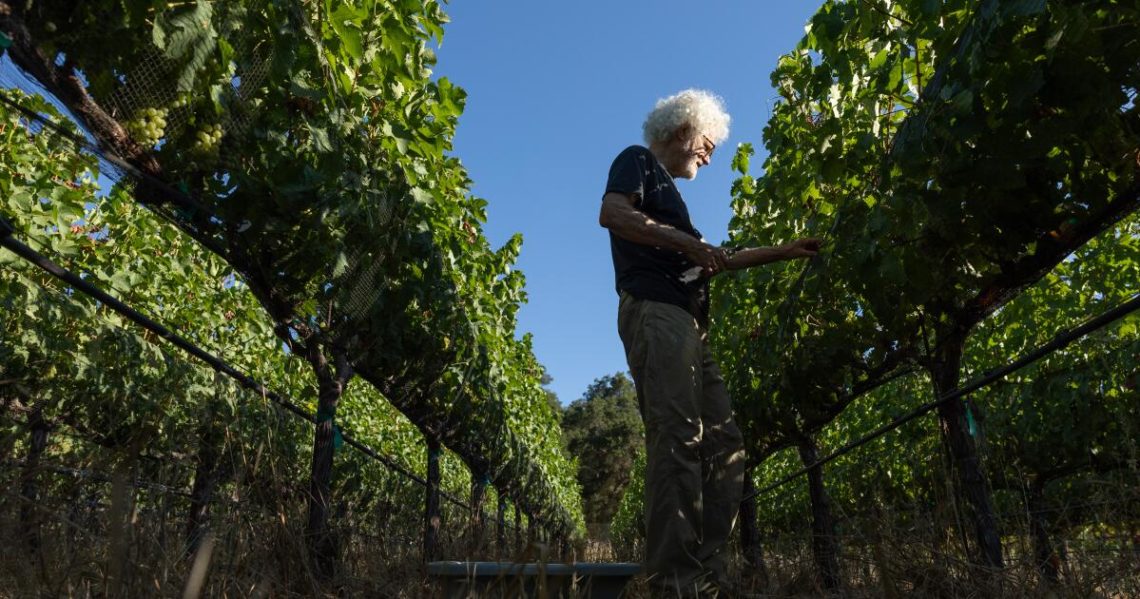In the summer of 1985, Adam Tolmach began to notice that something was rapidly killing the precious estate vineyard he had planted just a few years earlier. Each time the Ojai Vineyard winemaker replanted, the vines quickly perished.
It soon became clear that his vines — mostly Syrah, Semillon, Sauvignon Blanc and Zinfandel — were victims of Pierce’s Disease, a lethal bacterium spread by insect carriers that has reemerged as a serious threat to California’s wine industry.
As grape growers face a stretching list of existential threats, accelerated by climate change, a future where vineyards can survive without heavy reliance on chemical treatments will require shifts in farming and a rethinking of what wine will look and taste like.
That future will almost certainly include what are known as “hybrid” grapes in vineyards across the globe, industry insiders say. Tolmach, who helped establish the Central Coast as a bona fide source for world class wine, is a pioneer leading the way.
Where Tolmach once grew grapes with household names, in 2017 he planted newly bred varieties no wine drinker had ever heard of: two reds, Paseante Noir and Walker Red, alongside two whites, Ambulo Blanc and Caminante Blanc. Now these are bottled as Tolmach’s “Estate Red” and “Estate White.”
They are the literal fruits of decades-long research led by now-retired Dr. Andrew Walker of UC Davis’ Department of Viticulture and Enology. Bred specifically to resist Pierce’s Disease, the hybrids — officially released just six years ago — are the result of a cross between a European species, Vitis vinifera, and a wild North American one, Vitis arizonica.
For “the future of wine and our ability to make it in a more sustainable way, these new hybrids point the way,” says Tolmach.
“They’re not about imitation; they’re about expression. Free from the constraints of fragile, high-maintenance varieties, we can grow these grapes organically, with no spraying and no crutches. That means healthier vineyards, more vibrant soils and wines that are shaped more by terroir than by chemistry or convention.”
Improving hybrids
When you enjoy a glass of Pinot Noir, Chardonnay, Cabernet Sauvignon or Syrah, you are drinking Vitis vinifera. While that species has been responsible for the planet’s greatest wines, it is highly susceptible to diseases, pests and mildew common in North American vineyards. Successful propagation here has often relied on heavy chemical use and intensive farming practices.
Hybrids capable of withstanding these pressures have been in use for over a hundred years, especially in areas such as Virginia, Vermont and the Finger Lakes, where mildew presents a constant challenge. But these are not resistant to Pierce’s Disease, and have failed to gain much traction with consumers. Their flavors and aromas can be off-putting due to the low percentage of Vitis vinifera, the grape species responsible for the complexities that define the world’s greatest wines.
The grape breeding program at UC Davis is now led by Dr. Luis Diaz-Garcia, who says the substantial advances in breeding will help make hybrids an easier pill for consumers to swallow.
“The negative reputation of some hybrids, especially those developed in the early 1900s, is mostly due to their low vinifera content. With current hybrids now exceeding 90% to 95%, there’s no meaningful difference in quality compared to pure vinifera varieties. As time progresses, both fruit and wine quality improve, due to the increasing percentage in each generation.”
Uncharted waters
Tolmach had no idea how these grapes would perform in the vineyard. “Interestingly, the white varietals we are growing had parents that were red. Which is to say that with a hybrid you truly can get something completely different; it’s a bit like having kids, you don’t really know what you are going to get.”
Diaz-Garcia says Tolmach is swimming in uncharted waters. “As breeders, we can’t test these grapes under every possible climate, soil type or vineyard management system. And given how important terroir is in grape and wine production, there’s still a lot to learn.”
Tolmach says he is thrilled with the early returns. “Every vine, with the exception of about five of them, is alive, healthy and producing.” After years of working with Pinot Noir (a notoriously low-yielding variety), “I was shocked at how prolific these new hybrids are. They grow with huge vigor and require a lot of handwork to keep them under control.”
For Tolmach, the unknowns didn’t end in the vineyard. “It was a total mystery of how we were going to grow it. I think it takes at least five years and probably realistically more like 10 years just to get a feel for what you’re doing.”
He also says he needed to liberate himself from certain preconceptions. “I sort of imagined the wine in a certain way, and I needed to stop imagining and just let the grape speak to me.”
How they taste
A recent tasting of all five bottled vintages with a group of seasoned Los Angeles wine professionals made it clear that the grapes have spoken to Tolmach. Notably, one topic that never surfaced was whether the wines tasted like “hybrids.” They tasted like great wine.
“I think these wines need to be presented as real wine. No apologies, no hedges, no equivocations, no explanations,” says Los Angeles sommelier and consultant Taylor Parsons. “This is a great winegrower farming in an extraordinary historical moment trying to figure out a way to keep doing what he does long into the future.
“So why segregate these hybrids, or mark them from birth as some sort of less-thans?”
Wine tends to be a space where consumers follow the flock rather than flaunt their independence. “In most other agricultural pursuits, people prize the new varieties that come out, the new tomato or whatever,” Tolmach said. “But for wine, we prize these ancient varieties. The problem is that as diseases develop and the weather changes, they are not always the ideal thing for a particular spot. But it’s hard to let go of Pinot Noir.”
With limited production, the lion’s share of these new wines are sold at his downtown Ojai tasting room or via the Ojai Vineyard website. A handful of restaurants feature the wines, including at the newly opened Hotel El Roblar, just a few blocks from the tasting room.
Production is increasing incrementally. In 2020, Tolmach purchased Fe Ciega, a vineyard about 60 miles northwest of his home site. While Ojai is hot and arid, the Santa Rita Hills are shaped by Pacific air funneled through a valley, creating one of the most distinctive growing climates on the Central Coast.
This region has become a source for prized bottlings of Chardonnay, Pinot Noir and Syrah. When Tolmach identified an outbreak of Pierce’s Disease among the Chardonnay vines at Fe Ciega, he chose to replace them with additional plantings of Paseante Noir.
“It looks super promising as far as quality; we’re pretty excited by it,” Tolmach says. The tiny amount of fruit harvested to date has been blended into the Estate Red. This year, he expects a far larger crop, though hasn’t yet decided how to use it.
Pierce’s Disease is no longer confined to Southern California, and its spread into vineyards farther north marks a troubling escalation. Pierce’s isn’t caused by climate change, but the way it behaves is being changed by it. “The warmer the winter and the warmer the nights, the higher probability that the Pierce’s Disease bacteria will overtake the plant and the plant will eventually perish,” says Caleb Mosley, executive director of Napa Valley Grapegrowers.
“As the climate warms and disease pressures rise, these vines offer an environmentally gentle path forward, rooted in deep breeding work, not genetic shortcuts,” Tolmach says. “The wines they produce are honest, structured and nuanced. They are new voices, yes, but grounded in the timeless idea that wine should taste like where it comes from.”
David Rosoff is a sommelier and wine writer in Los Angeles.
The post Goodbye, Pinot Noir — hello, Paseante Noir? appeared first on Los Angeles Times.




